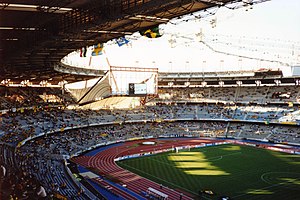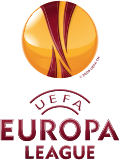Stadio delle Alpi
| Stadio delle Alpi | |
|---|---|

|
|
| Stadio delle Alpi (1990) | |
| Data | |
| place |
|
| Coordinates | 45 ° 6 '34 .5 " N , 7 ° 38' 28.5" E |
| classification | 4th |
| opening | 1990 |
| demolition | 2009 |
| surface | Natural grass |
| architect | Studio Hutter |
| capacity | 69,041 |
| Societies) | |
|
|
| Events | |
The Stadio delle Alpi ( German Alpine Stadium ) - also known as delle Alpi for short - was a football stadium with an athletics facility in the Italian city of Turin .
The stadium was designed by Studio Hutter and completed for the 1990 World Cup . The official audience capacity was 69,041 seats. Between 1990 and 2006, the rival soccer clubs Juventus Turin and AC Turin played their home games there. It replaced the Stadio Comunale at the time . The Stadio delle Alpi was demolished in the summer of 2009 to enable the Juventus Stadium to be built in the same place .
history
During the soccer World Cup in 1990, three group matches, a round of 16 and the semi-final between Germany and England took place in the stadium , which the DFB-Elf won on penalties .
In the 1990s, the stadium was often relatively crowded. With the general decline in attendance in Serie A and the temporary second division of AC Turin, the number of spectators fell sharply and the stadium was only sold out for major Champions League and a few Serie A games by Juventus.
The stadium was considered modern, but also oversized. It also had some architectural flaws. Of the lower places in the first tier, little was seen of the playing field because it was lower. In winter the stadium was very cold and drafty. The Stadio delle Alpi was planned as a multifunctional stadium and had a running track, but it was only used once for an athletics event. In contrast to the Stadio Comunale in Turin , the delle Alpi was outside the city and was therefore never particularly popular with fans of both Turin clubs.
In June 2003 Juventus signed a 99-year lease with the city of Turin for the area around the stadium itself. From May 2006 the stadium was originally supposed to be completely rebuilt. Juventus planned to build a pure football arena in the existing stadium. The new stadium should only have 43,000 seats, but have restaurants, cinemas and shops. The cost of the renovation was estimated at around 100 million euros. Because of the manipulation scandal in Italian football and the associated resignation of the entire Juventus management, the plans were initially put on hold.
In January 2007, the new Juve managing director Jean-Claude Blanc presented a new plan for an arena similar to the Volksparkstadion in Hamburg. The new stadium should have around 42,000 seats and cost around 120 million euros. The entire project should be linked to the award of the 2012 European Football Championship to Italy. On April 18, 2007, however, UEFA decided to host the 2012 European Football Championship in Poland and Ukraine .
In November 2008, the association published the final plan for the new building. Hernando Suarez and Gino Zavanella were won as architects. The entire complex houses the new stadium with a total of 40,200 seats as well as an entertainment center with several restaurants and shops. The club itself wanted to invest around 75 million, the rest should be paid for through sponsors.
From the 2006/07 season, Juventus and Turin FC played their home games in the Stadio Olimpico , the converted Stadio Comunale . After the demolition of the delle Alpi , the Olimpico is the sole home of AC Turin, while Juventus switched to the Juventus Stadium , which was built on the site of the delle Alpi , on September 8, 2011 .
Web links
- Official website of Juventus Turin (multilingual)
- Official website of FC Turin (multilingual)
Individual evidence
- ↑ Article on www.juventus.com (English) ( Memento from March 15, 2009 in the Internet Archive )
